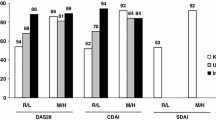Abstract
This paper aims to examine the interchangeability of the disease activity score in 28 joints (DAS28)-erythrocyte sedimentation rate (ESR) and DAS28-CRP scores in a diverse sample of rheumatoid arthritis (RA) patients and to evaluate generalizability over gender, age, and disease duration. A sample of 682 patients was drawn from the DREAM registry. Agreement between the two DAS28 scores was analyzed using the intraclass correlation coefficient (ICC), Bland Altman plots, and a matrix of classification agreement over DAS28 disease activity categories. Despite a strong linear correlation between the DAS28 scores and a high ICC value of 0.931, a considerable lack of individual agreement could be observed, with Bland-Altman 95 % limits of agreement ranging between −0.85 and +1.25 points. On average, DAS28-CRP scores were 0.20 points lower than DAS28-ESR scores, and data stratification on age and gender showed that this systematic bias was most severe in older women (0.39 points). The overall classification agreement across DAS28 categories was 76.69 %, with the agreement being lowest (35.37 %) in the low disease activity group. Patients were more easily classified as being in remission when using the DAS28-CRP measure. DAS28-ESR and DAS28-CRP scores are not interchangeable within individuals. The DAS28-CRP tends to yield lower values of disease activity than the DAS28-ESR, resulting in substantial classification differences.




Similar content being viewed by others
References
Prevoo ML, Van’t Hof MA, Kuper HH, Van Leeuwen MA, Van de Putte LB, Van Riel PL (1995) Modified disease activity scores that include twenty-eight–joint counts: development and validation in a prospective longitudinal study of patients with rheumatoid arthritis. Arthritis Rheum 38(1):44–48
Vermeer M, Kuper HH, Hoekstra M, Haagsma CJ, Posthumus MD, Brus HL, van Riel PL, van de Laar MA (2011) Implementation of a treat-to-target strategy in very early rheumatoid arthritis: results of the Dutch Rheumatoid Arthritis Monitoring remission induction cohort study. Arthritis Rheum 63(10):2865–2872
Emery P, Van Vollenhoven R, Ostergaard M, Choy E, Combe B, Graninger W, Krueger K, Matucci-Cerinic M, Navarro F, van Riel P, Settas L, Steinfeld S (2009) Guidelines for initiation of anti-tumour necrosis factor therapy in rheumatoid arthritis: similarities and differences across Europe. Ann Rheum Dis 68(4):456–459
Van Riel PL, Fransen J, Scott DL (2004) EULAR handbook of clinical assessments in rheumatoid arthritis. van Zuiden Communications, Alphen aan den Rijn
Fransen J, Welsing PMJ, de Keijzer RMH, van Riel PLCM (2003) Disease activity scores using C-reactive protein: CRP may replace ESR in the assessment of RA disease activity. Ann Rheum Dis 62(Suppl 1):151
Matsui T, Kuga Y, Kaneko A, Nishino J, Eto Y, Chiba N, Yasuda M, Saisho K, Shimada K, Tohma S (2007) Disease Activity Score 28 (DAS28) using C-reactive protein underestimates disease activity and overestimates EULAR response criteria compared with DAS28 using erythrocyte sedimentation rate in a large observational cohort of rheumatoid arthritis patients in Japan. Ann Rheum Dis 66(9):1221–1226
Wells G, Becker JC, Teng J, Dougados M, Schiff M, Smolen J, Aletaha D, van Riel PL (2009) Validation of the 28-joint Disease Activity Score (DAS28) and European League Against Rheumatism response criteria based on C-reactive protein against disease progression in patients with rheumatoid arthritis, and comparison with the DAS28 based on erythrocyte sedimentation rate. Ann Rheum Dis 68(8):954–960
Inoue E, Yamanaka H, Hara M, Tomatsu T, Kamatani N (2007) Comparison of Disease Activity Score (DAS)28- erythrocyte sedimentation rate and DAS28- C-reactive protein threshold values. Ann Rheum Dis 66(3):407–409
Hensor EM, Emery P, Bingham SJ, Conaghan PG (2010) Discrepancies in categorizing rheumatoid arthritis patients by DAS-28(ESR) and DAS-28(CRP): can they be reduced? Rheumatology 49(8):1521–1529
Skogh T, Gustafsson D, Kjellberg M, Husberg M (2003) Twenty eight joint count disease activity score in recent onset rheumatoid arthritis using C reactive protein instead of erythrocyte sedimentation rate. Ann Rheum Dis 62(7):681–682
Paulus HE, Ramos B, Wong WK, Ahmed A, Bulpitt K, Park G, Sterz M, Clements P (1999) Equivalence of the acute phase reactants C-reactive protein, plasma viscosity, and Westergren erythrocyte sedimentation rate when used to calculate American College of Rheumatology 20 % improvement criteria or the disease activity score in patients with early rheumatoid arthritis. J Rheumatol 26(11):2324–2331
Crowson CS, Rahman MU, Matteson EL (2009) Which measure of inflammation to use? A comparison of erythrocyte sedimentation rate and C-reactive protein measurements from randomized clinical trials of golimumab in rheumatoid arthritis. J Rheumatol 36(8):1606–1610
Radovits BJ, Fransen J, van Riel PLCM, Laan RFJM (2008) Influence of age and gender on the 28-joint disease activity score (DAS28) in rheumatoid arthritis. Ann Rheum Dis 67(8):1127–1131
Leeb BF, Haindl PM, Maktari A, Nothnagl T, Rintelen B (2007) Disease activity score-28 values differ considerably depending on patient’s pain perception and sex. J Rheumatol 34(12):2382–2387
DAS28. Radboud University Medical Centre. http://www.das-score.nl/das28/en/. Accessed August 28 2013
Bland JM, Altman DG (1986) Statistical methods for assessing agreement between two methods of clinical measurement. Lancet 1(8476):307–310
Wolfe F (1997) Comparative usefulness of C-reactive protein and erythrocyte sedimentation rate in patients with rheumatoid arthritis. J Rheumatol 24(8):1477–1485
Kushner I (1991) C-reactive protein in rheumatology. Arthritis Rheum 34(8):1065–1068
Firestein GS, Budd RC, Harris ED Jr, McInnes IB, Ruddy S, Sergent JS (2009) Kelly’s textbook of rheumatology. Saunders Elsevier, Philadelphia
Conflict of interest
This is an unfunded study and the authors declare that they have no conflicts of interest.
Disclosures
None.
Author information
Authors and Affiliations
Corresponding author
Rights and permissions
About this article
Cite this article
Siemons, L., Vonkeman, H.E., ten Klooster, P.M. et al. Interchangeability of 28-joint disease activity scores using the erythrocyte sedimentation rate or the C-reactive protein as inflammatory marker. Clin Rheumatol 33, 783–789 (2014). https://doi.org/10.1007/s10067-014-2538-x
Received:
Revised:
Accepted:
Published:
Issue Date:
DOI: https://doi.org/10.1007/s10067-014-2538-x




